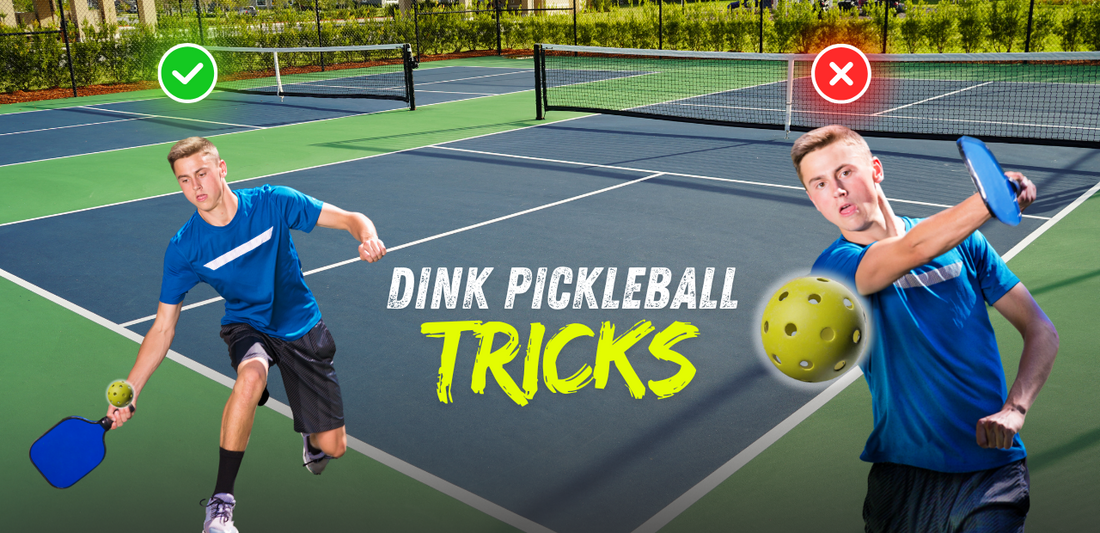If you’ve been playing the pickleball game for a while, you’ve probably heard the word "dink" tossed around courtside. But what exactly is a dink in pickleball, and why is it such a game-changer?
In this blog, we’ll break down smart dink pickleball tactics, show you when and how to use them, and explain why mastering this soft shot can throw off even the toughest opponents. Whether you're just starting or looking to sharpen your strategy, these tricks are designed to give you the upper hand.
What Is a Dink in Pickleball?

A dink is a soft, controlled shot that just clears the net and lands in your opponent’s non-volley zone, also known as the kitchen. This move forces opponents to play low and reduces their ability to attack. Dinks are most effective when both players are near the net, leading to strategic back-and-forth exchanges known as dink rallies.
Mastering the dink requires finesse, patience, and the right equipment—like a reliable pickleball paddle and a consistent pickleball ball. If you're on the hunt for quality gear, check out options built for control and feel.
How to Hit the Perfect Dink Shot

- Get Close to the Kitchen Line: Position yourself just behind the non-volley zone. Being close gives you better control over soft shots.
- Bend Your Knees and Stay Low: Keep your stance wide and low. This improves balance and helps lift the ball gently with your legs.
- Keep the Paddle Out Front: Avoid large backswings. Use a soft, short motion with your pickleball paddle and aim to contact the ball out in front.
- Light Grip Pressure: Relax your grip. A soft hold improves touch and makes it easier to control direction and height.
- Practice Consistency: Repeat your dinks until you can land them reliably in the kitchen. It's better to be accurate than aggressive.
When to Use a Dink in a Pickleball Game
- Third-Shot Drop: After the serve and return, the third shot is often a good time to dink. It gives you time to move up to the kitchen line and reset the rally.
- During Dink Battles: If both players are at the net, controlled dinks help maintain pressure without giving your opponent anything easy to attack.
-
To Slow Down Power Players: Facing someone who loves to slam? Use dinks to control the pace and draw them into a slower, more strategic game.
Dink Placement Tricks That Confuse Opponents
- Target the Corners of the Kitchen: Hitting angled dinks toward the far edges of the non-volley zone makes your opponent stretch and opens up the middle.
- Aim at the Feet: Dinking to your opponent’s feet forces awkward returns and limits their attacking options.
- Change Directions Often: Alternate between cross-court and straight dinks. The change in angles keeps them guessing.
- Vary Depth: Mix short dinks with deeper ones that land near the kitchen line. This variation disrupts timing.
- Use the Middle Gap in Doubles: In doubles, aim dinks between your opponents. Miscommunication often leads to missed shots.
Defensive and Offensive Uses of Dinks
- Defensive: Use soft dinks to reset points when you're in trouble. It slows the game and helps you regain control.
- Offensive: Use aggressive dinks—low, fast, and to the corners—to force errors and set up attack shots.
With the right pickleball paddle, you can control the speed and spin more effectively. Make sure to test paddles that suit your playing style.
Practice Drills for Better Dinks
- Wall Dinking: Practice hitting soft shots against a wall to improve consistency.
- Cross-Court Dinks: Rally diagonally with a partner to sharpen angle control.
- Target Zones: Place cones in different areas of the kitchen and aim for them repeatedly.
Playing regularly on well-maintained pickleball courts helps you adapt to different bounce behaviors and surfaces.
Final Thoughts
Dinks are more than just soft shots—they're strategic tools that shift the flow of the game. By mastering these dink pickleball tricks, you'll be better prepared to outsmart opponents, maintain control, and play smarter.
Pair your new skills with quality equipment like reliable pickleball paddles, a perfect pickleball ball, and sessions on proper pickleball courts.
So next time you step onto the court, remember: smart play wins games. And nothing is smarter than a perfectly placed dink.

